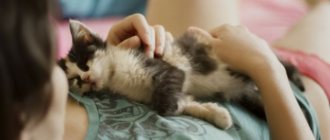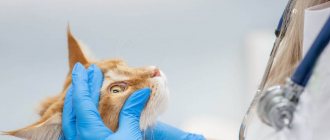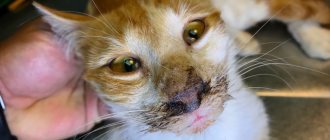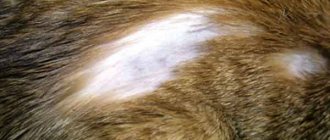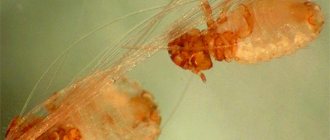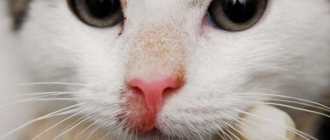The viral disease calcivirosis in cats is expressed by infection of the upper respiratory tract and oral cavity. The virus is dangerous for all breeds of cats and can infect both domestic and wild species. There are about 40 different strains of calcivirosis, the pathogenicity and severity of which differ significantly from each other. The disease is quite common; infection with the virus occurs through saliva and discharge from the nose and eyes. An infected cat sneezes, spraying the virus over a fairly large distance.
The calcivirus virus can survive in a polluted environment for 7 days, and even longer in a humid environment. An animal can become infected by contact with a sick person or by touching contaminated things. A cat owner who touches contaminated objects can also become a carrier of the virus. The disease is more severe in small kittens.
What organ systems are affected by the calcivirosis virus in cats?
Calcivirus in cats is characterized by the fact that it affects the upper respiratory tract, causing sneezing and pulmonary edema. Infection with the virus is manifested by wheezing in the chest, shortness of breath, pneumonia and bronchitis. In severe cases, the calcivirosis virus can affect the brain, disrupting coordination, as a result of which the animal becomes aggressive, loses orientation in space, and convulsions are observed.
The chronic form of the disease manifests itself mainly in adult cats and is no less life-threatening for the pet. With a slight malfunction of the immune system, calcivirosis becomes acute.
A particularly severe form, a virulent calcivirus systemic disease, is characterized by tangible organ damage, swelling of the limbs and face, hair loss and other pathogenic signs. Such infection by the virus leads to an increased mortality rate in cats, but is rarely recorded.
The virus can also infect the pet’s intestines and lead to the development of arthritis due to the virus affecting the musculoskeletal system. The causative agent of the disease is the FCV virus, which can mutate and cause diseases of varying severity. Experts identify another type of disease - virulent systemic calicivirus disease (VS - FCV). This virus provokes a particularly severe form of the disease, spreading more easily and more intensively than with the chronic or acute form of calcivirus. The pathological condition caused by this virus affects a large number of internal organs. The mortality rate from this disease is higher in adult cats than in kittens. The virus is resistant to many disinfectants. The risk group includes cats that live in poorly ventilated areas without the necessary hygiene procedures. Uncontrolled contact with stray cats is also dangerous.
The animal’s visual apparatus is also affected; the virus provokes acute serous conjunctivitis, ulcers and inflammation of the cornea in the cat.
In combination with bacteria and fungi, the disease can cause the death of the animal.
Diagnostics
Calcivirosis should be separated from other diseases with similar symptoms, for example, viral rhinotracheitis, chlamydia, bordetellosis (a respiratory disease of a bacterial nature), stomatitis, gingivitis. Calcivirosis can be suspected based on clinical signs, especially in the presence of ulcers. A general blood test will show a decrease in leukocytes characteristic of a viral disease. There are special diagnostic tests to determine FCV.
- Interesting facts about cats
- Cute dog breeds
- The richest animals
- Cat claw attachments
- Dog
- Long-eared cats
Alternatively, the virus can be isolated and grown in a laboratory using swabs from the mouth, nose, and conjunctiva of the eye. The result may be a false positive when the virus present does not cause disease. The result may also be a false negative, when the virus is present in small quantities and is not detected by tests. For symptoms such as difficulty breathing or claudication, an x-ray is recommended.
Incubation period and duration of the disease
The latent period lasts 5 days, after which pronounced symptoms appear, progressing every day. The duration of treatment is up to 24 days. After this, the stage of recovery begins, and it is possible to carry the virus for a long period of time or throughout life. The infection is transmitted by airborne droplets and has the specificity of maintaining vital activity for up to 1 day outside the cat’s body. Even after complete recovery, the cat can continue to release the virus into the environment for 2 months. Symptoms of the disease may not appear in the animal itself, but the cat will be dangerous to surrounding cats for about 30 days.
When a cat suffers from a simple type of illness, the disease goes away within 14 to 20 days, without intervention.
How much danger is there for the other cats living in the house?
It is believed that a sick cat begins to massively release the pathogen into the external environment approximately three weeks from the moment of infection. As we have already said, pets that are carriers of the infection constantly spread the virus in the external environment, despite the time that has passed since “recovery.” If they come into contact with young cats or kittens, the probability of getting sick for the latter is close to 100%.
In the case when your pet is vaccinated and more than three weeks have passed since vaccination, the entry of the pathogen into its body either passes without consequences, or a disease develops, but it proceeds in the mildest possible form. But does everything depend on vaccination? For example, can a cat who has already had calcivirus get sick again? We have already answered this question earlier. If everything is in order with the animal’s immunity and nutrition, then no. Antibodies present in the blood of a convalescent (recovered) person will reliably protect him from relapse. If the cat is old, malnourished, or recovering from a severe infection, the likelihood of recurrence of the disease increases. True, repeated pathology will almost certainly be much easier, the likelihood of severe consequences is very low.
Video
Features of the disease in kittens
In small cats, the disease is more pronounced and has a rather severe course, fraught with dangerous consequences. Adults who have already received vaccinations and have no health problems can survive the infection without external manifestations of the disease.
- In a kitten, the disease begins with a high fever. There is an increase in body temperature up to 40 degrees. The condition lasts for 3 days, after which it gradually returns to normal.
- An increase in temperature is accompanied by discharge from the baby's eyes, nose and mouth. The cat's chest and chin are constantly wet.
- Abscesses containing clear fluid form on the palate, tongue, lips and tip of the nose.
- Often a kitten will experience diarrhea, alternating with constipation. There are cases when an animal vomits at the very beginning of the disease, just once.
- The cat coughs, it is difficult for her to swallow, and the act of swallowing may be impaired. In this case, you should feed the baby liquid food; if he refuses to eat, you can feed him with a syringe.
- The inflammatory process also affects the pet’s gums. They swell and turn red.
- Over time, all the alveoli are opened and ulcers form in their places, which are difficult to heal, causing pain and discomfort to the baby. Such open wounds are also dangerous from the point of view of the penetration of other infections into the body. Ulcers should be regularly disinfected with special means.
- Along with the appearance of lethargy and general weakness, a rotten smell begins to stink from the animal’s mouth.
At the first symptoms, you need to urgently consult a doctor and complete the entire course of treatment prescribed by him, otherwise a cat with reduced immunity may die if the disease recurs.
During the period of the baby's illness, it is necessary to give more fluids, support the body with vitamins, mineral supplements and stimulants to increase the body's resistance.
How can you become infected with calcivirus?
FCV is highly contagious.
The virus can enter a cat's body through the eyes, nose or mouth. This can occur through direct contact with an infected cat or through an infected environment. For example, when a cat sneezes, the virus “scatters” several meters. The source of infection can be the floor, bedding, food, water and utensils, excrement, as well as clothing, shoes and people’s hands. Calcivirus can live for up to seven days on the territory or objects with which a sick cat has been in contact. And it is resistant to most disinfectants.
The spread of the disease is facilitated by crowded keeping of cats, violation of the vaccination regime, non-compliance with hygiene rules, poor ventilation of the room, etc.
Symptoms
One of the signs of calcivirosis is a thick yellow and purulent discharge from the eyes.
The following symptoms are typical for a pet infected with calcivirus:
- Increased temperature and general malaise of the pet;
- The formation of ulcers in the oral cavity, in particular on the lips, tongue, hard palate, also on the nostrils, mainly on their middle fissure;
- Shortness of breath, difficulty breathing, which indicates lung damage;
- Purulent discharge from the sinuses, lacrimation;
- Disorientation in space, convulsions, lameness;
- Oppressive odor from the mouth;
- Diarrhea, vomiting.
About methods of preventing calcivirosis
Since this pathology is highly infectious, and any “stranger” cat can be a carrier, you are unlikely to be able to protect your pet from infection. Even if the cat sits at home all the time, you yourself can bring the pathogen on your shoes or clothes. In particular danger are “breeding” cats and pets that are constantly taken to exhibitions. Even the most conscientious organizer of such events cannot guarantee the complete absence of sick animals and carriers.
Never, ever use used grooming items, carriers, feeding bowls, etc. without prior thorough disinfection. Moreover, if you were visiting or just outside, do not be lazy after your walk to wipe your shoes and wash your hands thoroughly. Ideally, of course, your pet should not come into contact with your outdoor clothing and shoes at all, but in reality, such isolation is unrealistic. But in cases where you are going to bring a new cat into your home, it won’t hurt to quarantine for a month . Many animal clinics and hotels provide such services. True, where is the guarantee that your new pet will not have time to “catch” the infection already there... So such prevention helps, but not always. Alas, the specificity of the disease affects it.
Since the causative agent of infection can be everywhere, proper disinfection of all care items and premises for keeping animals is of great importance. As we have already said, the calcivirus is not very persistent in the external environment, and therefore to destroy it it is enough to hold the “conditionally infected” item in a disinfectant solution (you can take ordinary chlorine bleach and water in a ratio of 1:32).
Vaccination
Can vaccination protect a cat from disease? Despite the wide variety of strains and very “average” vaccines, their administration is very useful. Despite the fact that vaccination is not able to 100% protect your pet from infection, vaccinated animals get sick much faster and with less consequences than if you compare them with unvaccinated pets.
The first time it should be done between 6 and 16 weeks of age, after that - exactly one year later. Depending on the level of antibodies in the animal’s blood (it can be detected by conducting a serological test), revaccination is done every year or every three years. In addition, unscheduled administration of the vaccine is useful in cases where you are planning to move, participate in exhibition events and other situations where your pet will often come into contact with other animals, the health status of which you most likely have no idea about. But still, the decision on the need for re-vaccination should be made only by a veterinarian.
Treatment of calcivirosis in cats
To organize correct and targeted treatment, you need to conduct a medical examination of your pet at a veterinary clinic. Certain studies are carried out and tests are taken:
- Blood analysis. With calcivirosis, the number of red blood cells and hemoglobin in the blood decreases.
- DNA test. It is carried out after unsuccessful treatment with antibiotics.
- Immunofluorescence analysis. Allows you to identify antigens and antibodies of microbes.
- If necessary, an x-ray of the lungs .
You should not undertake treatment yourself without first checking with a veterinarian. Owners often confuse calcevirus with distemper, and improper treatment and wasted time can cost the cat’s life.
The veterinarian prescribes treatment based on examination results. Certain groups of drugs are used.
Apply:
- Broad-spectrum antibiotics;
- Sulfonamide drugs;
- Corticosteroids;
- Vitamin B 12, E;
- Medicines with a targeted effect against swelling of the nasopharynx;
- Painkillers, immunostimulants and anti-inflammatory drugs.
Droppers are used for dehydration.
Mechanisms of virus infection
The source of infection for cats is another infected animal. However, the virus is not transmitted to humans, dogs and other pets, since the disease is specific only to representatives of the cat family. However, among cats, susceptibility is 100%.
The main routes of transmission of infectious pathology include:
- Airborne droplets from direct contact between a pet and an infected animal. In this case, the cause of the disease may be a cat carrying calcivirosis, which does not have any external signs of infection.
- Contact and household path. Scientists have proven that the virus has a high degree of resistance to direct sunlight and lack of moisture. Pathogenic microorganisms remain active for 12 days, remaining on household items, toys, and dishes.
The nutritional route of infection, in which transmission of the virus occurs through contaminated water and food, remains relevant.
Due to 100% susceptibility, it is very dangerous to transport a pet around the city on public transport without personal protection.
Drugs for the treatment of calcivirus in cats
A frequently used antiviral drug is Cycloferon. The medicine can be easily combined with all symptomatic remedies, activates the effects of antibiotics and prolongs their action. The injection is performed subcutaneously.
In severe forms of the disease, Dexamethasone is used to reduce swelling, allergic symptoms and eliminate shock.
The infection may be accompanied by conjunctivitis in the pet. In order to alleviate the condition of a sick cat, the eyelids are washed, then Tsiprolet, eye drops for cats, is instilled.
The drug has an antibacterial effect. An excellent option against inflammation and pathogenic microbes is the medicine Ciprovet for cats.
Since calcivirosis can provoke arthrosis in an animal, Stride + is used for cats. The medication prevents damage to cartilage tissue, damage to the integrity of the joint surface, and stimulates metabolic processes.
When choosing an antiseptic, you need to pay attention that many of them have a bitter taste and a sick cat who is vomiting and dislikes food may have a very difficult time taking the medicine, and then, fearing discomfort, refuse to eat.
Effectively used:
- Antibiotics Tylosin and Tetracycline for the prevention of chlamydia and treatment of pneumonia;
- A solution of Naphthyzin is instilled into the nasal passages, which makes breathing easier and relieves heavy flows from the animal’s nose;
- Miramistin or another disinfectant is used to treat open wounds and the mouth;
- To prevent dehydration, the cat is given an infusion of saline or glucose.
During treatment, the cat must be fed liquid food. If the pet refuses to eat, it must be fed using a syringe.
After an infection you should:
- Provide the cat with high-quality food, coordinating the regime with a special veterinary diet;
- Clean the tray with special means;
- Monitor discharge from the eyes and nose and remove it with a clean napkin;
- Add vitamins and minerals prescribed by your doctor to the food.
Treatment of the disease
How to treat calcivirus in cats? Therapy must begin with a correct diagnosis. Without this, treatment cannot be started, because each infection has its own pathogen, which requires specific treatment. So, for calcivirus, it is necessary to prescribe a special hyperimmune serum that contains antibodies to the pathogenic microorganism.
However, if the disease is uncertain, a multicomponent serum should be immediately administered against three viral ailments: panleukopenia, calicivirus, and rhinotracheitis.
If the pet does not eat for a long time or has vomiting, frequent loose stools, or an elevated body temperature, then it is important to place IVs and inject subcutaneous saline solutions of sodium chloride, glucose, and Ringer-Locke. They are used 20-50 ml every 6-12 hours. It should be taken into account that no more than 20 ml of saline solution can be injected under the skin into one place.
It is good to alternate injections and droppers with each other when treating calcivirosis in cats. In the morning you can use sodium chloride, and in the afternoon you can introduce a glucose solution, then again a saline solution, and then glucose. A glucose solution removes intoxication well, promotes the removal of toxins, and a sodium chloride solution helps restore the water-salt balance that occurs due to dehydration. Such alternations help avoid further death of body cells.
After the cat’s body has become sufficiently strong as a result of drug therapy, a therapeutic diet is necessary. Probiotics, that is, drugs that restore intestinal microflora, are introduced into the menu as prescribed by a veterinarian.
Medicines to treat an infected person:
- antibiotics that prevent the development of inflammation and pneumonia;
- vitamin and mineral complexes that strengthen and restore the strength of the convalescent;
- means that speed up metabolism and completely remove intoxication from the body;
- symptomatic treatment that supports the cardiac, respiratory, and digestive systems in a healthy state.
Mostly, medications are administered by injection, since the animal’s oral cavity is very sensitive due to ulcers. Tablets and liquid preparations will only increase the pain of the furry sufferer. Therefore, you will have to learn how to give injections yourself or invite a visiting nurse.
Features of treating a pregnant cat
Unfortunately, doctors are rarely able to save the offspring of a sick female. This is due to the fact that the body devotes all its strength to protecting the mother cat, and the fetus is practically defenseless. A specialist selects the appropriate treatment based on many factors: gestational age, number of fetuses, severity of the disease, etc. The owner’s task is to show the pet to the doctor on time and devote enough time to its treatment.
Features of kitten treatment
It is necessary to start therapy on the very first day the first symptoms appear, otherwise the chances of recovery are greatly reduced. The doctor prescribes a small patient a whole range of therapeutic measures, which include injections, rinsing and lubricating the mouth with medications, and a therapeutic diet. In some cases, hospital treatment may be required.
The main difficulty in treating children is choosing the dosage. Often a microscopic dose of a particular drug is required, and only a doctor can determine it. You cannot do this on your own - it will only harm the kitten.
The main rule for kittens less than six months old is to carry out a full course of treatment. If you complete the course recommended by the doctor a day or two earlier, the disease may return, with a vengeance and unpleasant consequences. It is optimal if the therapy ends after a complete examination of the patient at the veterinary clinic and the doctor confirms that the baby is healthy.
Aftercare
It should be remembered that after the final recovery, the pet will not be safe. Immunity is restored only within six months, but the danger of transmitting the virus remains.
Calcivirosis is considered one of the most serious diseases for felines, so it is worth taking care of the complete comfort of your pet. If there are other cats living at home, it is advisable to separate them from the sick person for a while. Be sure to check other cats for the presence of the virus by taking tests. If they are healthy, then it is necessary to vaccinate, and after quarantine and complete recovery of the patient, the animals can be placed together again.
Provide your cat with a comfortable bed or allocate a place on the sofa, chair, or bed. Try to stay nearby all the time.
Be sure to make sure that the water in the bowl is clean and warm: ulcers make it painful to drink liquid at room temperature. The food should be soft, puree-like: depending on the cat’s preferences, buy him pate or boil and chop lean meat (chicken, turkey, rabbit). The menu can be adjusted with the help of a veterinarian: he will recommend therapeutic nutrition and also prescribe the necessary vitamins and supplements. Some of them will have to be given in the form of injections.
Treatment at home
For non-severe forms of the disease, the cat can be treated at home. The cat needs to be isolated from other animals. Use medications every day strictly as prescribed by the doctor, also clean your nose and eyes with antibiotics, sanitize the oral cavity, rinse ulcers with medications and or chamomile decoction.
Be sure to administer Ringer's solution, sodium chloride, or glucose if there are signs of dehydration.
You need to monitor your pet’s diet, as this gentle food, rich in vitamins, guarantees your pet’s quick recovery.
Complications after calcivirosis
Frequent complications (in 30% of patients with feline calcivirus) are:
- Secondary bronchitis;
- Bronchopneumonia;
- Atelectasis;
- Increased nervous excitability;
- Twitching of limbs, convulsions;
- Weakening of the immune system;
- Brain damage.
Timely treatment will reduce the likelihood of serious complications that threaten the life of your beloved furry.
What is calcivirus
Feline Calicivirus (FCV) is a small virus (single strand RNA) that affects cats worldwide. Somewhat similar to our flu, it is a cause of upper respiratory and oral infections in cats. Although respiratory illnesses can be caused by a variety of viruses and bacteria, FCV is one of the most common infectious agents.
There are at least 40 different strains of calcivirus, causing illness with varying degrees of severity and symptoms. In addition, the virus is capable of mutating (changing over time, again similar to the influenza virus). Therefore, cats that have already had calcivirus or have been vaccinated against it may still show mild symptoms when reinfected with the new strain.
Vaccination against calcivirus after illness
To prevent the development of an infectious disease - calcivirosis, the pet is vaccinated annually with special preparations, after consulting with a veterinarian. Kittens are allowed to get vaccinated at 9 - 12 weeks of life. Vaccinations are very effective in protecting animals from serious consequences. If the cat was not promptly vaccinated against calcivirus infection, then there is a high probability that she may give birth to dead kittens due to illness during pregnancy.
Revaccination is carried out once a year; vaccination allows you to protect your pet from a serious viral disease by building its immunity. Calcivirus in a vaccinated cat occurs with more severe symptoms and in a mild form, without causing serious harm to the pet’s health.
Caring for a recovering cat
The information that calcivirus in cats can spread to humans and other animals is unfounded. The disease is species-specific, meaning only the cat family is affected. For this reason, you should not be afraid of contracting the virus and protect yourself and your family from a recovering pet, whose life is entirely in the hands of the owner.
The disease takes all the strength from the animal, so special attention needs to be paid to nutrition . The diet should contain high-calorie, easily digestible foods, which must be served in liquid form. You need to keep your pet clean and ventilate the room once a day. It is necessary to promptly remove discharge from the nose and eyes, and treat mouth ulcers.
Preventive measures
- It is necessary to minimize the pet's contact with other cats, especially to ensure that it does not have the opportunity to come into contact with stray animals.
- It is necessary to regularly ventilate the room and periodically carry out wet cleaning. Wash your pet's tray with soap and disinfect it with special products every 7 days.
- You need to feed your cat from special dishes, regularly disinfecting the cat’s bowl.
- If another cat (or several) appears at home, you need to endure a quarantine period of at least 10 days.
- If any pathogenic symptoms appear, the sick cat should be isolated from other pets.
- Maintain a calm and familiar environment around the sick animal. It is necessary to rid the cat of unnecessary stress, since against the background of nervous and emotional unrest, the disease may recur.
Calcevirosis is a rather dangerous disease, fraught with serious consequences. Timely diagnosis, properly organized treatment and care, regular vaccinations according to the schedule will help avoid irreversible consequences for your beautiful furry cat friend.
Interesting video:
Possible complications and consequences
Against the background of the cat’s weakened immunity by the virus, the body becomes infected with a bacterial infection. In this case, the cat develops bronchitis, stomatitis, and joints suffer from arthritis. In severe advanced cases, the animal develops pneumonia and then mandatory treatment in a hospital setting is required. For arthritis, subcutaneous injections of Ketofen 1% are recommended, as well as a suspension of Loxicom for internal use.
Animals that have recovered from the disease receive long-term immunity to the virus, destroying it completely. Some are its carriers for another 30-90 days. Nevertheless, more than 40 strains of calcivirus are known, which can mutate, so even vaccinated cats or those who have recovered from the disease are quite capable of becoming re-infected. Cats that carry calicivirus pass it on to their newborn kittens.
